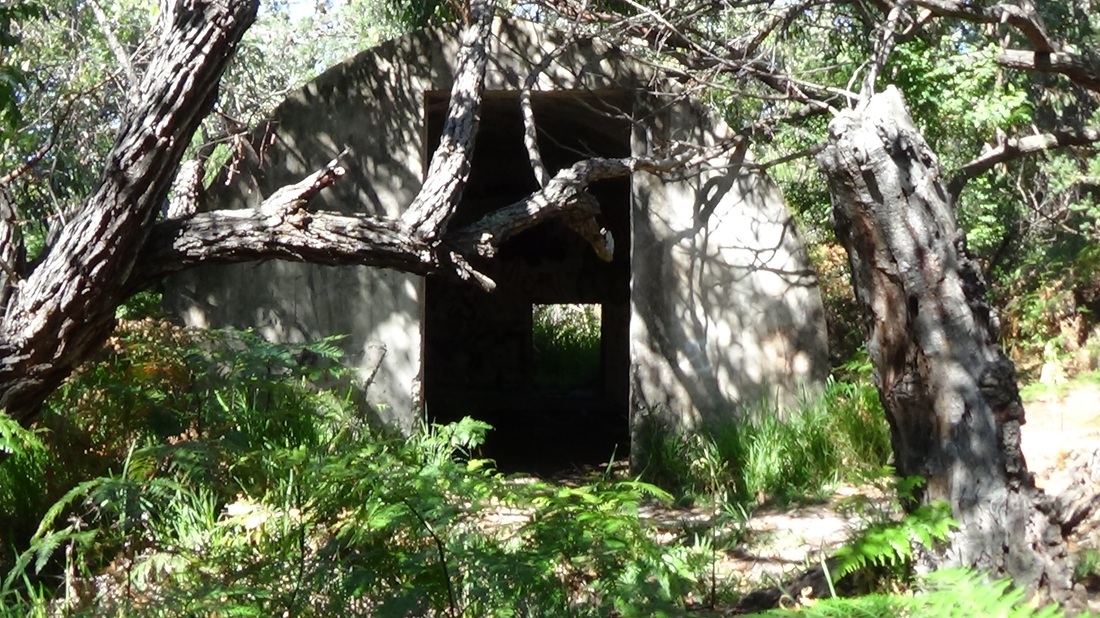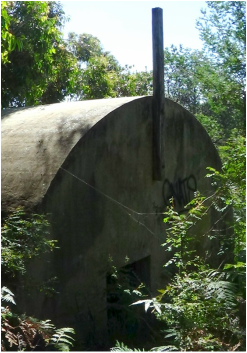Burrewarra Point
RAAF No 11 Operational Base Unit was stationed at Moruya Aerodrome during World War 2 (see the page for World War 2 in the Eurobodalla). An allied unit, RAAF No 17 Radar Station was formed there on 12 April 1943, initially as No 17 Radio Direction Finding Station. It was then located on Burrewarra Point and a part of the air warning organisation, it was to be a vital link in World War 2 seaward operations.
Plans were made in 1942 for a camp at Burrewarra Point to house 1 Officer and 45 Airmen and necessary services. No provision was made for females because of the isolation.
On 18 April 1943 Pilot Officer H.C. Harrison arrived as the first Commanding Officer and shortly afterwards on 23 April 1943 the installation of all Radio Direction Finding (RDF, this is what radar was first called) equipment was completed. Operations commenced on 29 April 1943. Over the next six months he was succeeded by Pilot Officer J.S. Flett (17 August 1943) and by Pilot Officer L. Birch on 15 October 1943. The station reached its peak personnel strength in December 1943 when 1 Officer and 46 airmen were located at Burrewarra Point.
In January 1944 the radar equipment plotted a ship to an extreme of 110 miles under abnormal conditions. This was an extraordinarily successful result.
Pilot Officer Birch was replaced by Flying Officer Sawford on 12 February 1944.
Plans were made in 1942 for a camp at Burrewarra Point to house 1 Officer and 45 Airmen and necessary services. No provision was made for females because of the isolation.
On 18 April 1943 Pilot Officer H.C. Harrison arrived as the first Commanding Officer and shortly afterwards on 23 April 1943 the installation of all Radio Direction Finding (RDF, this is what radar was first called) equipment was completed. Operations commenced on 29 April 1943. Over the next six months he was succeeded by Pilot Officer J.S. Flett (17 August 1943) and by Pilot Officer L. Birch on 15 October 1943. The station reached its peak personnel strength in December 1943 when 1 Officer and 46 airmen were located at Burrewarra Point.
In January 1944 the radar equipment plotted a ship to an extreme of 110 miles under abnormal conditions. This was an extraordinarily successful result.
Pilot Officer Birch was replaced by Flying Officer Sawford on 12 February 1944.
All that's left of RAAF No 17 Radar Station
On 8 February 1944 a site for an Airborne Surface Vessel Beacon was selected on the extreme end of Burrewarra Point and the installation was completed on 8 June 1944. The beacon was located 180 feet above sea level, and was later reported to have been received at 220 miles with correct coding. While the beacons began life as Airborne Surface Vessel detection beacons, they evolved into submarine detection roles as well, not only in the air, but on the sea and on the land as well.
A 50 yard rifle range was constructed during March 1944 and on 27 March 1944 a special watch was maintained on Burrewarra Point on the lookout for a suspected submarine which never eventuated.
As from mid 1944 No 17 Radar Station began to run down and by the end of July 1944 had reduced to 1 Officer and 18 airmen. Pilot Officer H.H. Milvain had taken over as Commanding Officer on 2 July 1944 and was replaced by Pilot Officer L.H. Esmore on 10 October 1944.
By November 1944 termites and borers were causing extensive damage to the buildings on Burrewarra Point and No 17 Radar Station ceased operations on 21 January 1945 pending reversion to a state of care and maintenance.
The unit remained in care and maintenance state until finally disbanded on 4 March 1946.
On 20 April 1996 members of the RAAF Association (NSW) Radar Branch affixed a commemorative plaque to one of the structures.
Burrewarra Point Reserve forms part of the Guerilla Bay-Burrewarra Point Area listed in the Register of the National Trust. It is one of the few World War 2 defence sites within Eurobodalla. A model of the radar installation is held by the Moruya and District Historical Society.
Strong wartime social links are recorded with the communities at Mogo and Moruya, including the use of historic places of entertainment such as the Amusu Theatre in Moruya, which became the Sewing Centre, 80 Vulcan Street, Moruya, it's now Silly Willy's Variety Store.
A 50 yard rifle range was constructed during March 1944 and on 27 March 1944 a special watch was maintained on Burrewarra Point on the lookout for a suspected submarine which never eventuated.
As from mid 1944 No 17 Radar Station began to run down and by the end of July 1944 had reduced to 1 Officer and 18 airmen. Pilot Officer H.H. Milvain had taken over as Commanding Officer on 2 July 1944 and was replaced by Pilot Officer L.H. Esmore on 10 October 1944.
By November 1944 termites and borers were causing extensive damage to the buildings on Burrewarra Point and No 17 Radar Station ceased operations on 21 January 1945 pending reversion to a state of care and maintenance.
The unit remained in care and maintenance state until finally disbanded on 4 March 1946.
On 20 April 1996 members of the RAAF Association (NSW) Radar Branch affixed a commemorative plaque to one of the structures.
Burrewarra Point Reserve forms part of the Guerilla Bay-Burrewarra Point Area listed in the Register of the National Trust. It is one of the few World War 2 defence sites within Eurobodalla. A model of the radar installation is held by the Moruya and District Historical Society.
Strong wartime social links are recorded with the communities at Mogo and Moruya, including the use of historic places of entertainment such as the Amusu Theatre in Moruya, which became the Sewing Centre, 80 Vulcan Street, Moruya, it's now Silly Willy's Variety Store.


